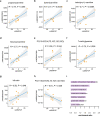Plasma metabolomics in the perioperative period of defect repair in patients with pulmonary arterial hypertension associated with congenital heart disease
- PMID: 34848852
- PMCID: PMC9253009
- DOI: 10.1038/s41401-021-00804-3
Plasma metabolomics in the perioperative period of defect repair in patients with pulmonary arterial hypertension associated with congenital heart disease
Abstract
The quality of life and survival rates of patients with pulmonary arterial hypertension associated with congenital heart disease (CHD-PAH) have been greatly improved by defect-repair surgery and personalized treatments. However, those who survive surgery may remain at risk of persistent PAH, the prognosis may be considerably worse than those unoperated. Dynamic monitoring of clinical measures during the perioperative period of shunt correction is therefore indispensable and of great value. In this study, we explored the plasma-metabolite profiling in 13 patients with CHD-PAH during the perioperative period of defect repair. Plasma was harvested at four time points: prior to cardiopulmonary bypass (CPB) after anesthesia (Pre), immediately after CPB (T0), 24 h (T24), and 48 h (T48) after defect repair. Untargeted metabolomics strategy based on UPLC Q-TOF MS was used to detect the metabolites. A total of 193 distinguishing metabolites were determined at different time points, enriched in pathways such as oxidation of branched-chain fatty acids. We found that 17 metabolite alterations were significantly correlated with the reduction in mean pulmonary arterial pressure (MPAP) at T48 versus Pre. Gradients in diastolic pulmonary arterial pressure (DPAP), bicarbonate in radial artery (aHCO3), bicarbonate in superior vena cava (svcHCO3), and the partial pressure of dissolved CO2 gas in radial artery (aPCO2) were positively correlated with MPAP gradient. Notably, these clinical-measure gradients were correlated with alterations in shunt-correction-associated metabolites. In total, 12 out of 17 identified metabolites in response to defect repair were increased at both T24 and T48 (all P < 0.05, except propionylcarnitine with P < 0.05 at T24). In contrast, galactinol dihydrate, guanosine monophosphate, and hydroxyphenylacetylglycine tended to decline at T24 and T48 (only galactinol dihydrate with P < 0.05 at T48). In conclusion, 17 metabolites that respond to shunt correction could be used as suitable noninvasive markers, and clinical measures, including DPAP, aHCO3, svcHCO3, and aPCO2, would be of great value in disease monitoring and evaluating future therapeutic interventions.
Keywords: congenital heart disease; defect-repair surgery; metabolites; metabolomics; perioperative period; pulmonary arterial hypertension; pulmonary circulation.
© 2021. The Author(s), under exclusive licence to CPS and SIMM.
Conflict of interest statement
The authors declare no competing interests.
Figures






Similar articles
-
Contemporary survival outcomes of congenital systemic-to-pulmonary shunt in children with borderline pulmonary vascular resistant index compared to Eisenmenger syndrome.Sci Rep. 2024 Jul 23;14(1):16867. doi: 10.1038/s41598-024-67899-6. Sci Rep. 2024. PMID: 39043775 Free PMC article.
-
Plasma Connective Tissue Growth Factor as a Biomarker of Pulmonary Arterial Hypertension Associated With Congenital Heart Disease in Adults.Circ J. 2023 Mar 24;87(4):527-535. doi: 10.1253/circj.CJ-22-0172. Epub 2023 Feb 25. Circ J. 2023. PMID: 36843115
-
The prognostic implications of perioperative endogenous hydrogen sulfide and nitric oxide levels in children with congenital heart disease complicated by pulmonary arterial hypertension.Eur J Pediatr. 2021 Jun;180(6):1915-1922. doi: 10.1007/s00431-020-03897-w. Epub 2021 Feb 8. Eur J Pediatr. 2021. PMID: 33555425
-
Targeted Therapies in Patients with Pulmonary Arterial Hypertension Due to Congenital Heart Disease.Curr Vasc Pharmacol. 2022;20(4):341-360. doi: 10.2174/1570161120666220811150853. Curr Vasc Pharmacol. 2022. PMID: 36125818 Review.
-
Management of pulmonary arterial hypertension associated with congenital systemic-to-pulmonary shunts and Eisenmenger's syndrome.Drugs. 2008;68(8):1049-66. doi: 10.2165/00003495-200868080-00004. Drugs. 2008. PMID: 18484798 Review.
Cited by
-
Small molecule metabolites: discovery of biomarkers and therapeutic targets.Signal Transduct Target Ther. 2023 Mar 20;8(1):132. doi: 10.1038/s41392-023-01399-3. Signal Transduct Target Ther. 2023. PMID: 36941259 Free PMC article. Review.
-
Regulatory T Cell-Related Gene Indicators in Pulmonary Hypertension.Front Pharmacol. 2022 May 31;13:908783. doi: 10.3389/fphar.2022.908783. eCollection 2022. Front Pharmacol. 2022. PMID: 35712711 Free PMC article.
-
Variation and significance of serum microRNA-21 level in pediatric pulmonary artery hypertension associated with congenital heart disease.Front Cardiovasc Med. 2024 Sep 5;11:1424679. doi: 10.3389/fcvm.2024.1424679. eCollection 2024. Front Cardiovasc Med. 2024. PMID: 39309603 Free PMC article.
-
Respiratory Microbiome Profile of Pediatric Pulmonary Hypertension Patients Associated With Congenital Heart Disease.Hypertension. 2023 Jan;80(1):214-226. doi: 10.1161/HYPERTENSIONAHA.122.19182. Epub 2022 Nov 10. Hypertension. 2023. PMID: 36353996 Free PMC article.
-
Identification of Zip8-correlated hub genes in pulmonary hypertension by informatic analysis.PeerJ. 2023 Aug 28;11:e15939. doi: 10.7717/peerj.15939. eCollection 2023. PeerJ. 2023. PMID: 37663293 Free PMC article.
References
-
- Galie N, Humbert M, Vachiery JL, Gibbs S, Lang I, Torbicki A, et al. 2015 ESC/ERS Guidelines for the diagnosis and treatment of pulmonary hypertension: The Joint Task Force for the Diagnosis and Treatment of Pulmonary Hypertension of the European Society of Cardiology (ESC) and the European Respiratory Society (ERS): Endorsed by: Association for European Paediatric and Congenital Cardiology (AEPC), International Society for Heart and Lung Transplantation (ISHLT) Eur Heart J. 2016;37:67–119. doi: 10.1093/eurheartj/ehv317. - DOI - PubMed
MeSH terms
Substances
LinkOut - more resources
Full Text Sources
Medical

